The Intel Core i5-7600K (91W) Review: The More Amenable Mainstream Performer
by Ian Cutress on January 3, 2017 12:01 PM ESTLegacy and Synthetic Tests
At AnandTech, I’ve taken somewhat of a dim view to pure synthetic tests, as they fail to be relatable. Nonetheless, our benchmark database spans to a time when that is all we had! We take a few of these tests for a pin with the latest hardware.
Cinebench R10
The R10 version of Cinebench is one of our oldest benchmarks, with data going back more than a few generations. The benchmark is similar to that of the newest R15 version, albeit with a simpler render target and a different strategy for multithreading.
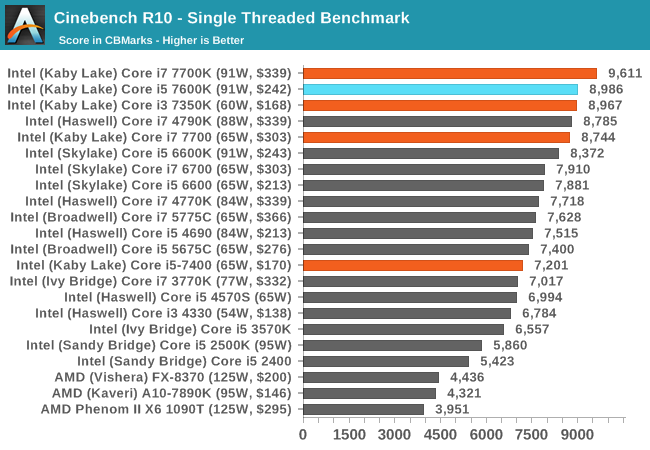
With high frequency in tow, the Core i5-7600K matches that of the previous generation i7-6700K, and goes above the Devil’s Canyon i7 as well.
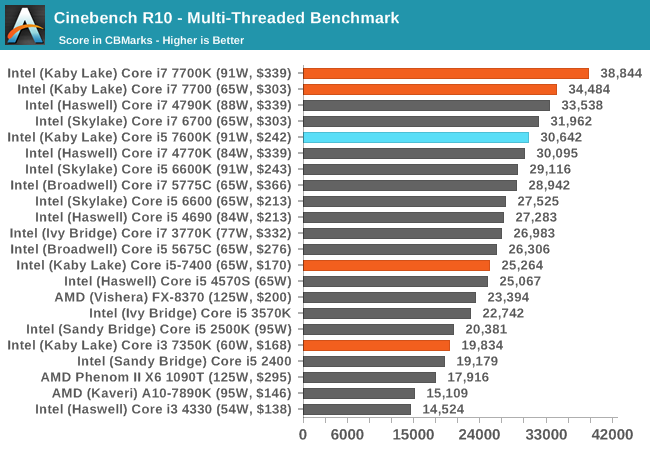
When more threads come to play, the Core i5-7600K sits atop all the other i5 parts, and because hyperthreads have little effect here, the combination of IPC and frequency pushes the Core i5-7600K above previous top performers such as the Core i7-4770K.
Cinebench R11.5
CB11.5 has been popular for many years as a performance test, using easy to read and compare numbers that aren’t in the 1000s. We run the benchmark in an automated fashion three times in single-thread and multi-thread mode and take the average of the results.
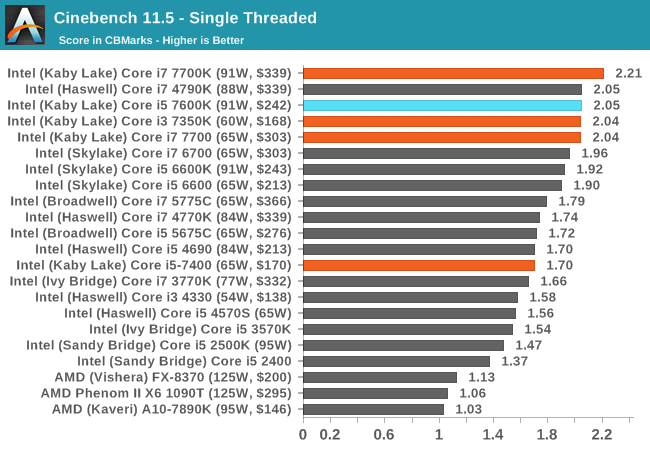
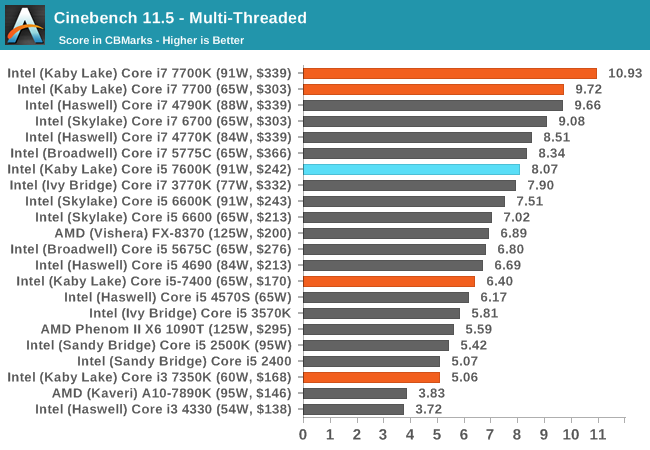
Out of the box the i5-7600K hits above a 2.00 on the single threaded test and above 8.00 on the multithreaded test, showing that the scaling with cores on CB11.5 is very reasonable.
7-zip
As an open source compression/decompression tool, 7-zip is easy to test and features a built-in benchmark to measure performance. As a utility, similar to WinRAR, high thread counts, frequency and UPC typically win the day here.
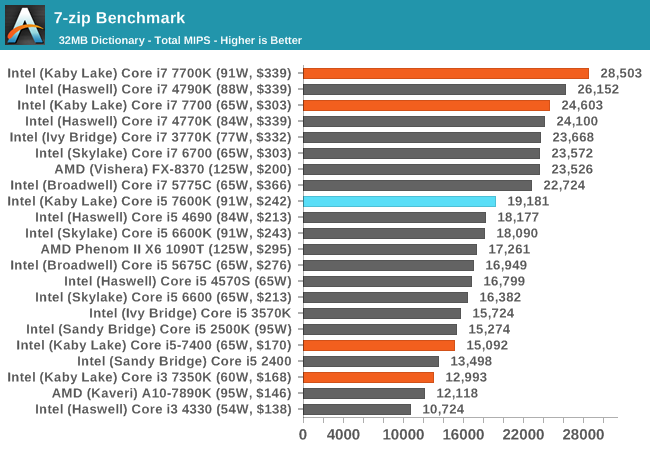
The Core i7-7700K shows the benefits of frequency over a stock i7-6700K, however at the same frequency they perform roughly the same as expected.
POV-Ray
Ray-tracing is a typical multithreaded test, with each ray being a potential thread in its own right ensuring that a workload can scale in complexity easily. This lends itself to cores, frequency and IPC: the more, the better.
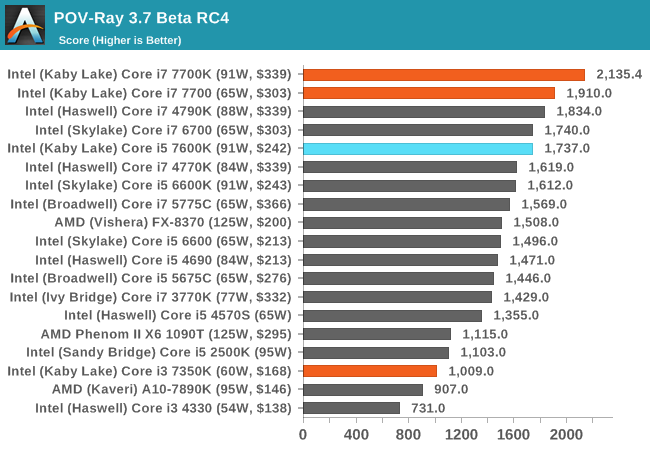
AES via TrueCrypt
Despite TrueCrypt no longer being maintained, the final version incorporates a good test to measure different encryption methodologies as well as encryption combinations. When TrueCrypt was in full swing, the introduction of AES accelerated hardware dialed the performance up a notch, however most of the processors (save the Pentiums/Celerons) now support this and get good speed. The built-in TrueCrypt test does a mass encryption on in-memory data, giving results in GB/s.
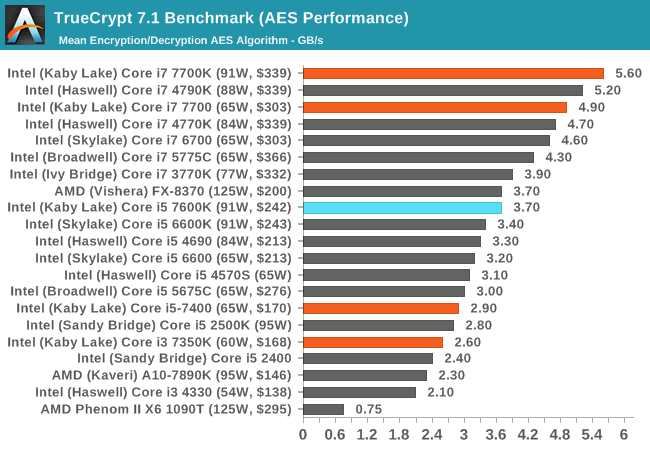










70 Comments
View All Comments
lopri - Wednesday, January 4, 2017 - link
It's not Zen but it's their own chips of the past years. They even admit that the IPC is unchanged from Sky Lake, so the only way to sell this chip as something new is by jacking up the "official" clock frequency.Bullwinkle J Moose - Tuesday, January 3, 2017 - link
How is preventing anyone from securing their own computer an upgrade?How is limiting what you can do on your computer an upgrade?
It is now legal for the FBI to hack into ANY computer ANYWHERE as long as you are using Windows 7/8 or 10, but I can stop them with XP
So how is this an Upgrade?
Security trumps your definition of "upgrade"
Murloc - Tuesday, January 3, 2017 - link
they don't prevent you from using linux, BSD or even your own custom OS and securing your computer.jimbo2779 - Wednesday, January 4, 2017 - link
What does any of this or your other posts have anything to do with the processor reviewed.Can you go post this in a comment section about win vista - 10 so the rest of us aren't subjected to it.
This article is about a cup not Windows.
Thanks.
Bullwinkle J Moose - Tuesday, January 3, 2017 - link
because Windows XP IS Secure if you know what you're doing!and my Windows software IS compatible with Windows, not Linux
eldakka - Wednesday, January 4, 2017 - link
And most software that requires windows XP and is on 10-year old hardware will run just fine under an emulation environment (e.g. wine) on Linux. Or even inside a Windows XP VM running on a linux host OS.Emulation is of course much slower than native, but running an emulator on current generation hardware will still be faster than running native on that 10-year old hardware.
That way you can get a modern operating system with support for modern hardware, without the windows 8/10 spyware, while still being able to run your old winXP apps.
But if you have no desire or need to get a modern OS, if you are happy with XP and the performance that you get on your current hardware, then why the hell are you even asking these questions and looking here? The only reason you'd be looking and asking these questions is if you are interested in upgrading.
Bullwinkle J Moose - Wednesday, January 4, 2017 - link
you sound confused eldakkawhat exactly is your point of running a secure OS from within a spyware platform with backdoored bitlocker encryption, keylogger, DRM and Windows components you cannot block in your firewall ?
It is TRUE that Windows 10 is the most secure Version of Windows EVER, but Microsoft should finish the sentence.....
Windows 10 is the most secure Version of spyware EVER for the FBI and the NSA, but NOT the End Loser (er...user)
Funny how the Snowden Interview video disapeared from the Internet explaining how he could watch you as you type and edit your text at your computer BEFORE you send the message with your "secure" encrypted messaging app
Those backdoors are there for a reason.....To spy on and hack any "modern" Windows Computer in the World which is why MS had to kill XP and why the Law was changed to allow the FBI to hack ANY computers, anywhere with a single warrant (that went into affect December 1st)
The FBI could not do that if the back doors were closed, but you cannot close them on Windows 10
computers
But the REAL Trolls here won't discuss that now will they?
Dug - Thursday, January 19, 2017 - link
Because no one cares about your AWESOME Windows XP! Get of the Internets everyone!!!! OMG, Spy FBI CIA NSA HELPS ME!!!Really dude, you are awesome. Thanks for repeating the same crap over and over again and showing your real ignorance. If you really knew what you were doing, you wouldn't have to explain yourself.
Dug - Thursday, January 19, 2017 - link
And if you have SUPER SECRETS that you don't want anyone to know about, guess what?Don't go online? You do realize that just having any port open allows someone to see your packets. You really think your ISP is secure? Because once a packet leaves your house, it's not your network anymore.
If any of the mentioned entities really want information from you, they'll just come in and physically take it.
137ben - Wednesday, January 4, 2017 - link
The most secure operating system is one which allows for no input and gives no output. At that point, it's not a computer.